MIDLAND MICROCOSM
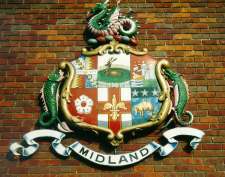
A Study of Signalling between Nottingham and Lincoln
With a Great Deal of Surviving Midland Railway Influence
DERBY AREA SIGNALLING
MIDLAND MICROCOSM

A Study of Signalling between Nottingham and Lincoln
With a Great Deal of Surviving Midland Railway Influence
Please note that I am no longer maintaining the web version of this document. The last substantive update to its content would have been c.2002. However, I am keeping it here for the pictures if nothing else! The article continues to be developed and the paper version has grown to over 16,000 words. With illustrations it is nearly 30mb so I hope you understand why posting it here isn't practical. If you are interested in obtaining a copy, please email me. Although not actively marketing it, it is available as a “private paper” for the cost of the postage.
Introduction
Amid rumours of a power scheme sited at West Holmes in Lincoln, I decided it was time I took stock of what the Nottingham — Lincoln line still has to offer in the way of signalling. This article takes a tour from Nottingham in the ‘Down’ direction detailing mot only what is to be seen today but also what has gone. Apart from a brief flirt with the GNR, this story is pure Midland, the line having its origins in the Midland Counties Railway, opening in 1846.
The Midland Railway had policy of regularly renewing and enlarging its signal boxes. It is clear that the MR signal engineers swept along this line in the first few years of the 20th Century replacing boxes with the then standard structure and an almost ubiquitous 16 lever tumbler frame. Thankfully, though, this was not a comprehensive renewal and until quite recently we were left with examples of virtually every Midland pattern signal box. Despite the inevitable rationalisation, there is still an almost complete range of Midland signal boxes to be found — including an increasingly rare ground frame hut.
Within the article you will find references to various “Types” of Midland Railway signal boxes. This terminology originates from the categorisation found in "The Signalbox" by the Signalling Study Group published by OPC (ISBN 0 86093 224 9). It has been pointed out to me that not everyone will be familiar with this work. Consequently there is an explanation of the various Types — as I understand them — elsewhere on this site.
Like any journey into the past there are gaps our knowledge. I am grateful to those listed the acknowledgements for helping to fill some of those gaps for me. There is still much to be learned and so I would welcome any additional information anyone has to offer.
Nottingham
Nottingham Station is within the Trent power signal box area which displaced mechanical signalling in the station when it was commissioned on 7th December 1969. The mechanical signalling of any large station is a complex subject and Nottingham is no exception. As such we'll leave the station environs and set off on our journey to Lincoln.
Our fictitious journey would have begun under the control of Nottingham Station East then London Road Junction before being accepted by Sneinton Junction
Sneinton Junction
Sneinton Junction is still operational, owing its existence today to a level crossing. It is a gate box under Trent’s supervision. Its own crossing is Meadow Lane which, although a fully equipped road crossing, it has had its approaches blocked off to all but pedestrians and cycles. Sneinton also controls Colwick Crossing by cctv.
The box is a Type 4c sited on the Up side 0m 35ch from Nottingham. It is the second box on the site, this one dating from 26th July 1914. The first box, it seems, dated from the original installation of signalling on the line sometime before 1869, so was well overdue replacement by Midland standards.
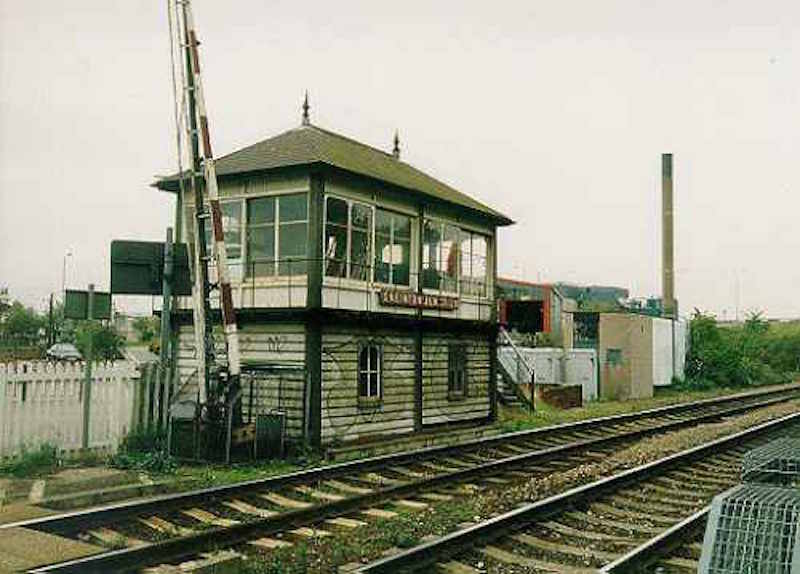
Sneinton Junction
Its frame is a Midland tappet reduced from 30 to 10 levers. Of all the boxes on the line, Sneinton is in by far the worst condition of any signal box on the line today. Not only has it suffered at the hands of the local vandals but also, it seems, the local S&T. The back of the box is seriously disfigured. Not only is there is a gaping hole hacked through the weatherboarding to accommodate a pipe of some description but where an advertising hoarding was once fastened, the timber of the box is exposed to the elements.
On a positive note, at least Sneinton Junction retains its Midland Railway nameboard fastened to the front of the box.
As recently as 1964 Sneinton Junction was the only connection between the former Midland and GNR lines via an exchange siding at London Road Low Level. Although this lack of a connection appeared not to hamper day-to-day workings, it was a big problem at weekends. The notorious level crossings in Lincoln seriously reduced capacity through the town limiting the number of east coast bound excursions to those bound for Cleethorpes. Skegness traffic was forced to reverse into the trailing connection for the exchange sidings at Sneinton Junction, much to the displeasure of those on Meadow Lane, no doubt! Once in the exchange sidings, an Eastern Region locomotive would take the train on the GNR line to Grantham. The connection at Carlton & Netherfield which opened to passenger traffic on 10th January 1965 put paid to all that.
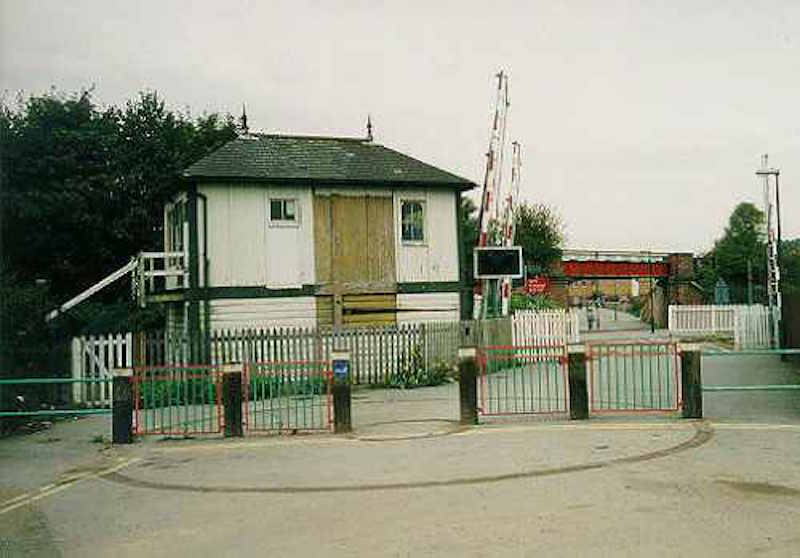
Sneinton Junction
Colwick Crossing
Colwick Crossing was west of the level crossing on the Down side at 1m 3c. It was a new box on 29th May 1893 which was made a crossing box on 7th December 1969 before being abolished on 14th December 1975 with Sneinton Junction taking over by cctv.
A Type 2b design it was constructed of a single 15’ x 10’ flake. In 1969 the box boasted its somewhat wordy "Colwick Level Crossing" nameboard on the front but by the time it had been reduced to a gate box it had lost it.
Netherfield Junction
Just before the Grantham line leaves us on the Up side, we pass from Trent’s control to that of Netherfield Junction — although we never see that box as it is 27 chains along the Grantham line on the Nottingham end of Netherfield station’s island platform. Although all bar one of its signals are colour light, it retains a 40 lever Railway Signal Co frame. The building is a non-standard (unique?) design from 1960.
The box works Track Circuit Block to Trent and Absolute Block to Rectory Junction on the Grantham line and Lowdham along our route. As the signalman can’t see Lincoln trains he is reliant on track circuits throughout.
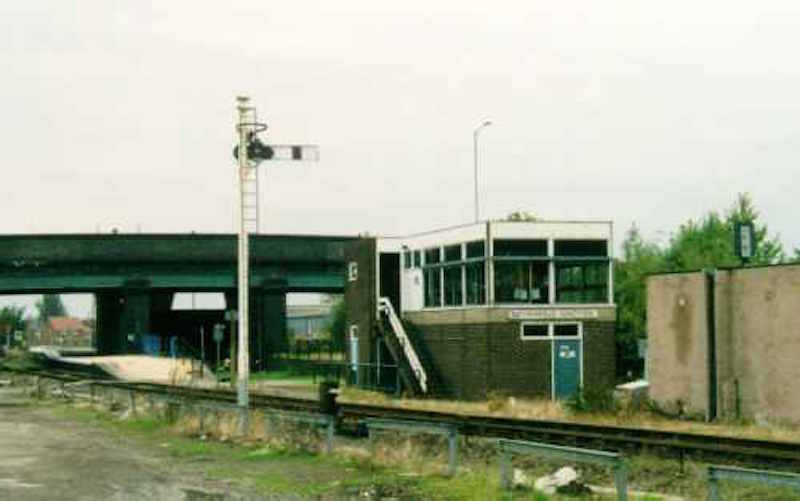
Netherfield Junction
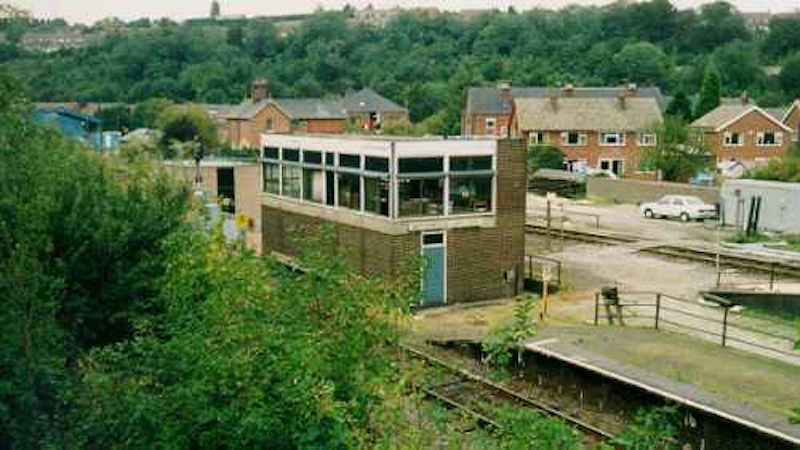
Netherfield Junction
Carlton & Netherfield Station
Onward toward Lincoln, past Carlton & Netherfield Station which lost its signal box on the Up side at 2m 78ch on 28th September 1980.
The station box was east of the level crossing with the station's two platforms each on either side of the crossing. It was a Type 2a and was formed of odd flakes. The non-steps end which faced the crossing was a 15’ flake with three pane deep windows whereas the door end which faced railway traffic on the Up was only 10’ long. This suggests an extension at some point to accommodate its 20 lever frame which was at the front of the box.
By 1978 there were eight spare levers in the frame and only the Down Home and Down Starter remained as semaphore signals with three and four aspect colour lights for the Up signals and the Down Distant.
The LMS practice of mounting signal box nameboards over the end windows had been adopted here and with quite a long name there was barely room to fit it all in!
Carlton & Netherfield Goods Yard box was located on the Down side of the line at 3m 19ch. This box had opened on 10th April 1904 and was abolished on 28th April 1957.
Burton Joyce Station
The Burton Joyce Station box which was abolished on 8th April 1984 was the second box on the site at 5m 1c. It was on the Up side at Lincoln end of the station and dated from 26th June 1910.
The railway runs very close to the River Trent on the Up side at this point. As it is effectively in the river's flood plain it is no surprise that Burton Joyce box has a brick base. The use of brick is very unusual by Midland standards although the alternative of under-filling with concrete because of rot isn't.
Burton Joyce was a Type 4a design comprised of a single 15’ x 10’ flake. It too had received an LMS pattern nameboard over each end. It became a gate box on 11th October 1970.
Lowdham
We come to the next open box at Lowdham on the Up side at 7m 27c. It is located on the Nottingham side of the level crossing with the station on the other side of the crossing. This is a Type 2b dating from 14th June 1896 containing a 16 lever MR tumbler frame. This box is in very good condition with its LMS pattern nameboards over the ends.
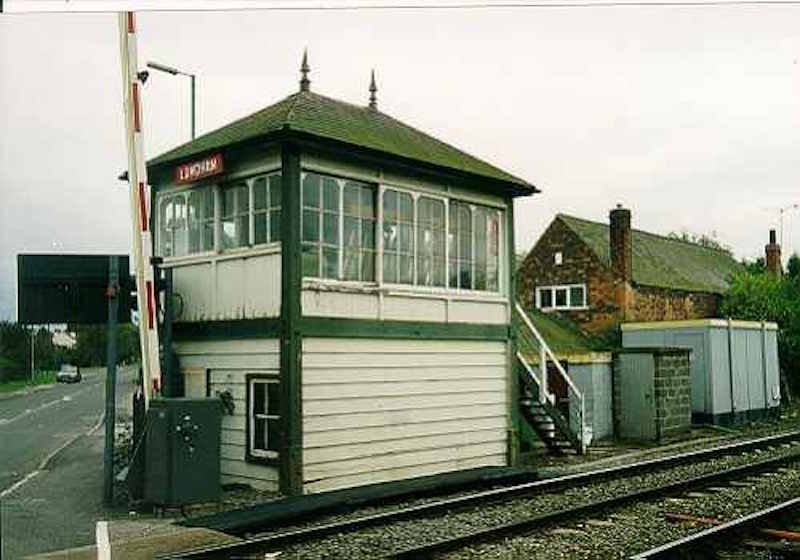
Lowdham
The station building here is in the hands of a Midland aficionado as it sports a lot of Midland ephemera — including a gas lamp with the station name in the glass.
Gonalstone
Never a signal box as such, this crossing is the subject of an interesting photograph by M.A.King dated 9th August 1970. By then the crossing had been converted to Automatic Half Barriers but the crossing keeper's hut remained. Bearing a Midland Railway style nameboard on the front, the building is about 5' square with a small window on the front. It is built with vertical weatherboarding and has a pitched roof. The gable ends are fitted with bargeboards which are plain except for a roundel at the end.
Clearly a structure of some antiquity but not a standard Midland design.
Thurgarton
Now we’re well into absolute block territory, we are given ‘on line’ to Fiskerton Junction. First we pass through Thurgarton Station, the signal box there had a similar history to Burton Joyce. It was located on the Down side, Nottingham end at 9m 42ch. It too was the second box there and dated from 22nd June 1902.
Unsurprisingly being as they were built within a month one another, Thurgarton was visually very similar to Fiskerton which we will come to soon. If anything Thurgarton was the slightly lower of the two with a mere five steps required to reach the operating floor. Despite its diminutive stature, the Midland saw fit to equip Thurgarton with a window cleaning stage, complete with safety rail.
The box had the 16 lever frame found in many of the boxes on the line. The frame was in the front of the box. Unlike the other boxes we have come across so far, there was no gate wheel provided here with the gates being operated by hand and locked by lever 11.
When photographed by Mr. King on 9th August 1970, the crossing at Thurgarton bore a sign reading "Between 11pm and 6am ring bell for gates" with a suitable button below. This of course suggests that even before it was reduced to a gate box during October 1970 it was regularly 'switched out' overnight. It was finally abolished on 8th March 1982 when Automatic Half Barriers were installed.
Bleasby
Bleasby station at 10m 55ch is unique on the line as it is the only one which never had a signal box. Although, as Mr. King captured on film in 1970, the crossing keeper was provided with a small brick built hut, complete with nameboard on the front.
As the architecture of this structure closely matches many of the station buildings on this line, I venture to suggest that this is probably contemporary with the opening of the line. That being the case we have an insight into the kind of building which predates the more traditional signal boxes.
The crossing was protected by signals interlocked with the hand worked gates by a five lever ground frame situated outside the building.
Fiskerton Junction
By now we’ve reached Fiskerton Junction at 12m 3ch. This is a charming box, set in a beautiful spot out in the countryside but really needs painting. It is a Type 4e on the Down side. It dates from 7th April 1929 being built to serve the short-lived Rolleston West Curve which was built to allow a direct Nottingham - Southwell path for trains to the then new Blidworth and Bilsthorpe collieries. It ceased to be a junction when the curve closed on 1st March 1965.
The box has a 30 lever REC tappet frame. John Hinson has provided a diagram for the box dated c.1968 at which time the signalling for the West Curve was still in place. At that time there were only six spare levers. Lever 23 was a “Closing Lever” allowing the ground frame to work the main line signals.
Today Fiskerton Junction retains its gates worked by a wheel from the box and its early LMS round cornered nameboard on the front which is almost certainly contemporary with the box as these round nameboards were only used during the period 1927 — 1935.
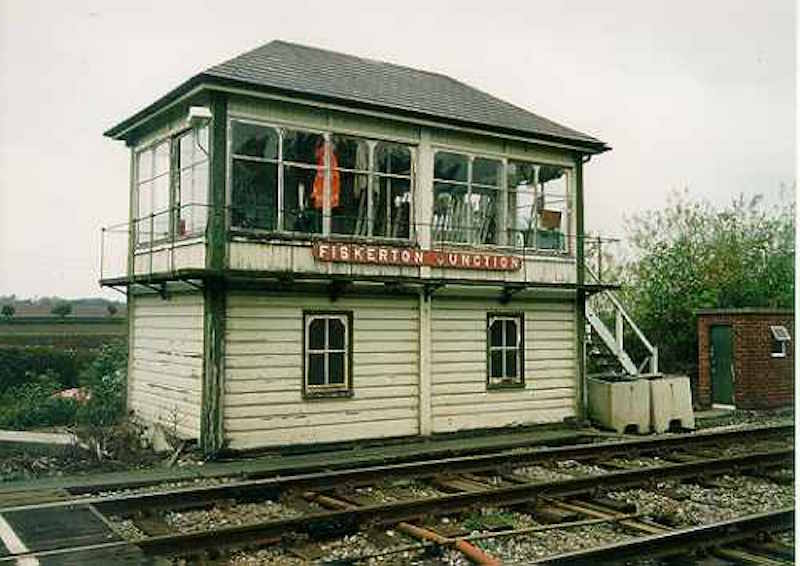
Fiskerton Junction
Also on the Down side here but on the Nottingham side of the crossing is a Midland pattern ground frame hut known as Morton Crossing. Complete with eight lever frame, the structure can be used as a gate box when the main box is switched out. It appears, however, that it is not in regular use.
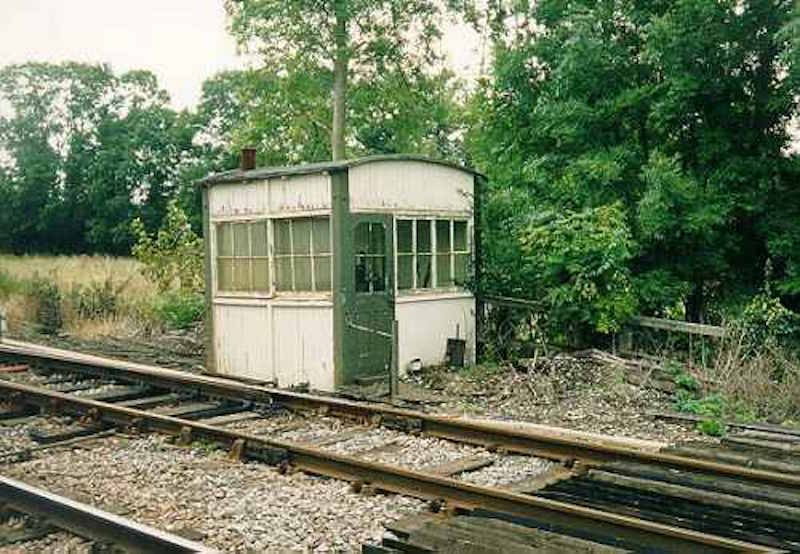
Morton Crossing Ground Frame
Fiskerton
Fiskerton is a real oddity — odd in the sense it has survived as a gate box since as long ago as 2nd December 1934. It is a Type 3a dating from 6th July 1902 located on the Down side at 12m 42ch. Like several boxes along here it has a 16 lever MR tumbler frame. Given its limited status and only five working levers the box has probably had the sea of white in its frame for a long time.
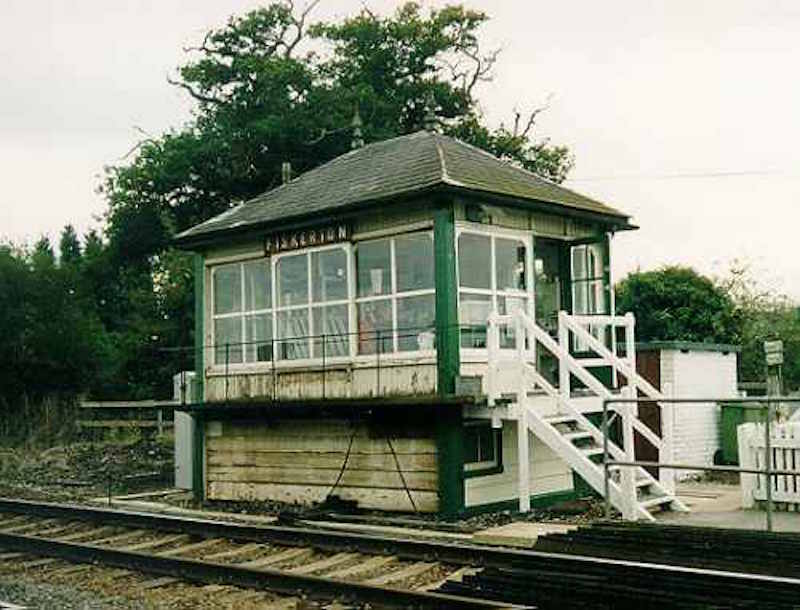
Fiskerton
In support of the assertion that Thurgarton was a lower box than Fiskerton, there are seven steps required here. The gates are hand worked like Thurgarton.
The 1937 LMS Sectional Appendix carries an instruction that drivers requiring to work at Fiskerton Station siding must obtain a special Wrong Line token at Rolleston Junction. Drivers in possession of such a token were then allowed to return to Rolleston Junction “Wrong Line” on the Up line.
The proximity to Fiskerton Junction means that Fiskerton’s Down Distant is carried on Fiskerton Junction’s Home and vice-versa on the Up. Both Fiskerton’s Down Home and Up Distant are still carried on Midland wooden posts — which is something of a rarity these days.
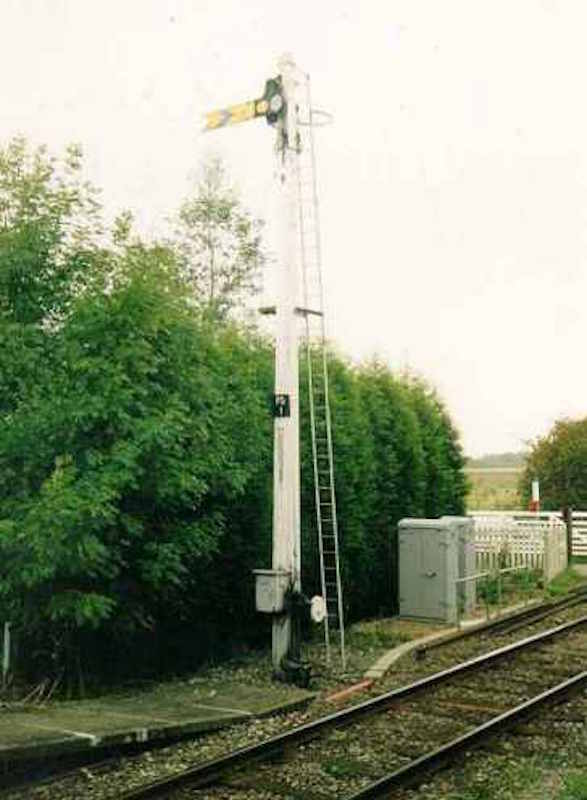
Fiskerton's Up Distant
Rolleston Junction
Fiskerton”s Up Distant is located between the Nottingham end of Rolleston station and crossing, which is operated by a crossing keeper supervised from Staythorpe Crossing. At the other end of the station, at 13m 18ch to be precise, stood Rolleston Junction signal box. At least it did until 2nd October 1966 when the Southwell branch closed along with the boxes on it.
Long before its abolition, being a Midland Type 1 box 15’ long and 10’ deep dating from 18th September 1883, Rolleston Junction would have been of historical value. As mentioned elsewhere, the Midland had a policy of regularly replacing and enlarging its signal boxes which makes the survival of this box all the more special. Regrettably, however, photographs of it seem rare. So far I have only been able to track down a long view of the box from the end of the Up platform. A decent shot of it would be a treasure to behold!
Just prior to closure the box retained quite a comprehensive layout with no spares amongst its 37 lever frame. There were loops on both sides with the Southwell branch curving off on the Down side - although the Up direction on the branch was toward Rolleston. Along the branch Rolleston Junction worked to Rolleston West which was the third corner of the triangular junction with Fiskerton Junction.
Rolleston Junction had three level crossings each interlocked with, but remote from, the box in all three directions.
Staythorpe Crossing
The newest box actually on the line is Staythorpe Crossing on the Down side at 14m 20ch. It is a LMS timber Type 11c, extended by 5’ at the non steps end from two 10’ flakes. It was opened on 8th October 1950 to serve the power station of the same name.
It contains a 35 lever REC tappet frame. Whereas now it has 19 spares as it lost most of its layout with the closure of the power station in the 1990's, it had a mere six spare circa 1970.
At that time it had two roads on either side - ‘A’ Reception and ‘A’ Run Round on the Up side and similarly named 'B' roads on the Down which still exist. The sidings on both sides had facing connections from the Down line. West of the level crossing, on the Up side was a trailing siding where sand from one of the many local gravel pits was loaded.
In the late 1970's the narrow level crossing was modernised with lifting barriers controlled from the box. Prior to this the crossing still boasted wheel-worked Midland Railway gates and a cast iron Midland Railway trespass notices on each side.
As befits its comparatively young age, Staythorpe Crossing is in fairly good nick, a slight droop in the middle notwithstanding! At some stage since 1970 some of the windows on the front of the box have been replaced with the older Design B windows which perpetuate the Midland style triangular piece in the top corners.

Staythorpe Crossing
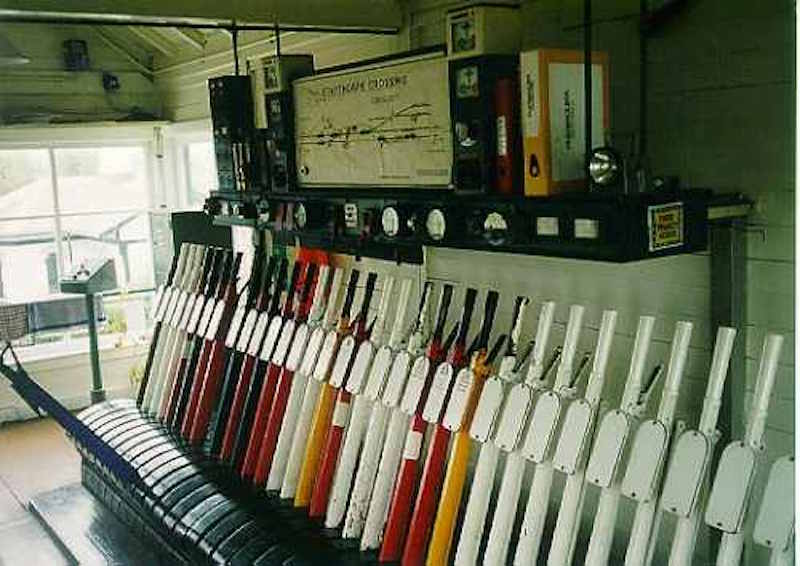
Staythorpe Crossing interior
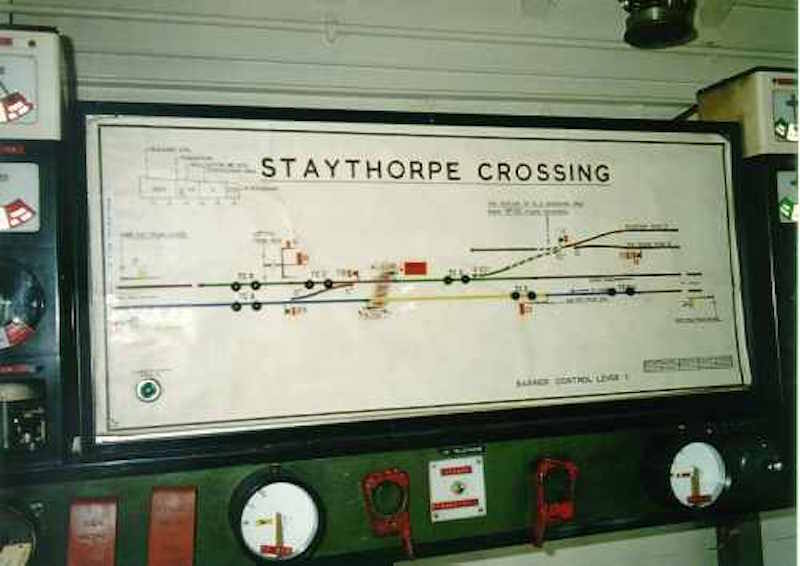
Staythorpe Crossing diagram
Newark Castle Station
Passing the site of Thorpe's Sidings /Parnham's Mill which was abolished on 17th April 1888, we arrive in Newark.
Newark Castle Station signal box is a Type 4a on the Up side at 16m 79ch. It is located between the level crossing and the Nottingham end of the station. This box is the third on the site being commissioned on 15th September 1912, replacing a structure from 3rd July 1887.
It retains its 16 lever Midland frame with tappet locking although nine levers are now spare. This is the first Midland box we have come across with its frame in the rear. This was not the usual position for a Midland frame but was far from unusual.
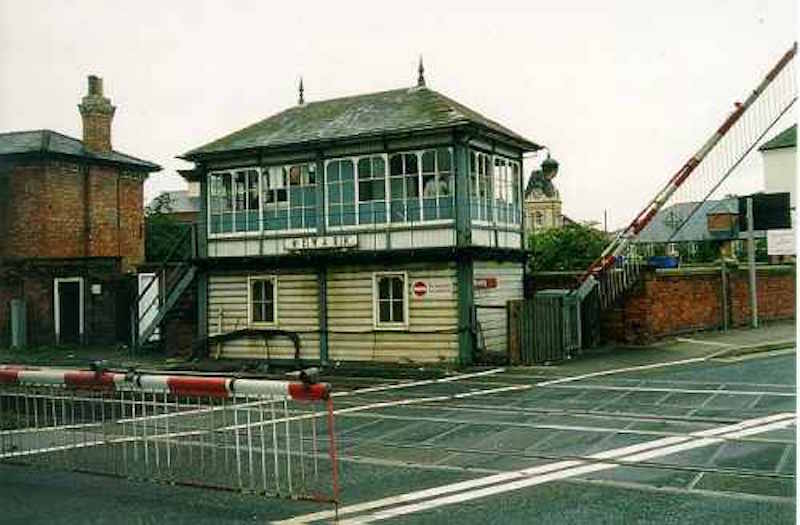
Newark Castle
At its height Newark had one of the most extensive layouts on the line. There were sidings on both sides with an exchange siding with the ex-GNR East Coast Mainline and small yard on the Up side. On the Down there was a short branch to a sugar beet factory.
It was no doubt much to the relief of the signalmen there when lifting barriers were installed as the level crossing is “The Great North Road” (The old A1) which even though it was by-passed was a very busy road.
Although it lost the remainder of its layout in the early 1980's, it retains a trailing crossover and discs - which are now its only mechanical signals. The crossover sees daily use with a terminating passenger service from Nottingham introduced in the winter timetable.
With the exception of the unusual abundance of modern graphical warning sings, especially on the locking room door, the box is in pretty good nick. With the frame being at the rear there is an unusual amount of paint on the windows at the front which gives the box a strange appearance.
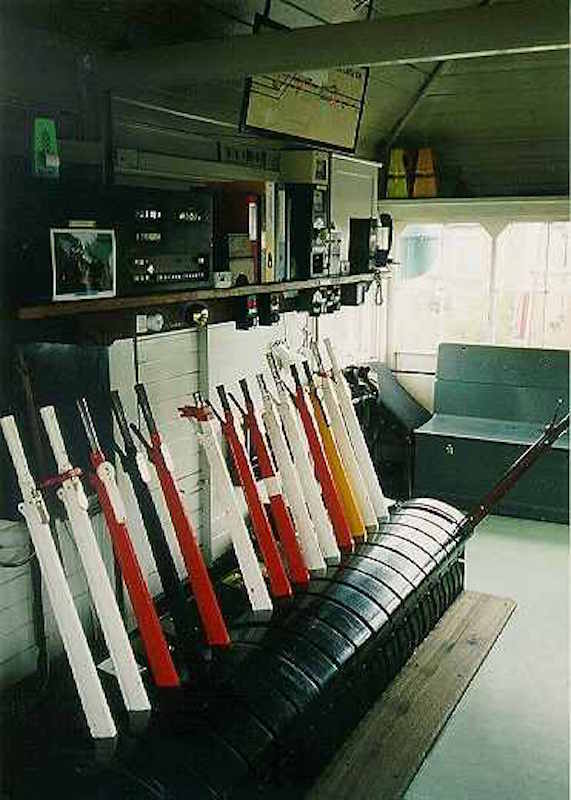
Newark Castle frame

Newark Castle layout 1950
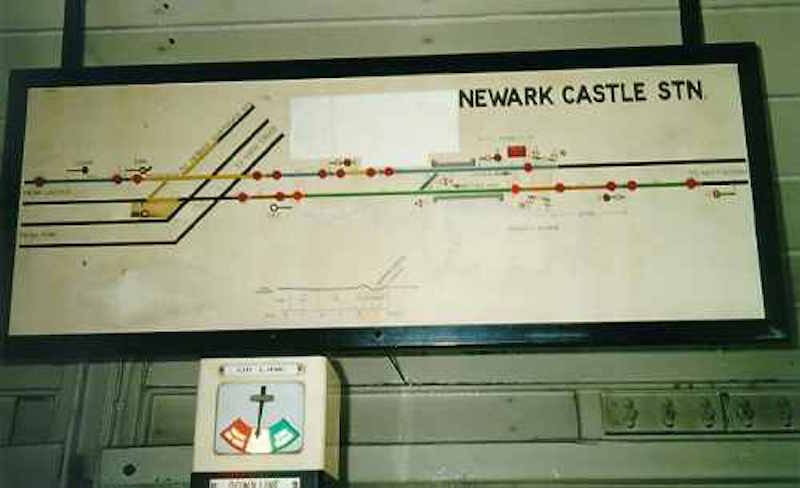
Newark diagram
Newark North
Until 21st March 1965 Newark Castle worked to Newark North which was on the Up side at 17m 19ch.
Newark Crossing
When Newark North closed the section was extended through to the GN box at Newark Crossing (17m 67ch). As most readers will know, Newark is the last of three infamous flat crossings on the East Coast Mainline (Stockton & Darlington Crossing and Retford being the others). Newark crossing is a legacy of the Midland beating the Great Northern by two years and the very flat landscape making a flyover virtually impossible — not to mention modern impediments such as catenery and the A46 by pass bridge.
Upon its closure on 17th May 1981, Newark Crossing was the oldest operational box on BR, dating from December 1869 — and it showed! By that time Newark Crossing controlled not only the ECML but over 6 miles of the ex-Midland line toward Collingham.
Newark Crossing was replaced by Doncaster panel and it to this box that Newark Castle now fringes to. A flat crossing in a TCB area presented its own problems as, apparently, track circuits couldn't be used on both routes. The compromise situation involves the use of axle counters on the Midland line.
Several times a day a movement takes place east of the flat crossing which is unusual on Britain’s railways in that passenger trains reverse while not in a station. Some Lincoln bound services call at Newark Northgate a movement which requires a reversal from the Midland line across onto a chord installed as recently as the 1960's. This chord facilitated the closure of ex-GNR lines in Lincolnshire as London - Cleethorpes services could be diverted away.
Winthorpe
On the Lincoln side of the flat crossing, Winthorpe box was at 19m 3ch between 31st July 1892 until abolition as early as 4th October 1914.
Cottage Lane Crossing
Although an early casualty of AHB being abolished on 22nd November 1967, Cottage Lane Crossing box still exists. It’s a Type 4d located on the Down side at 21m 16ch and dates from 6th March 1927 replacing a structure from 20th October 1895 which in turn replaced 1878 box.
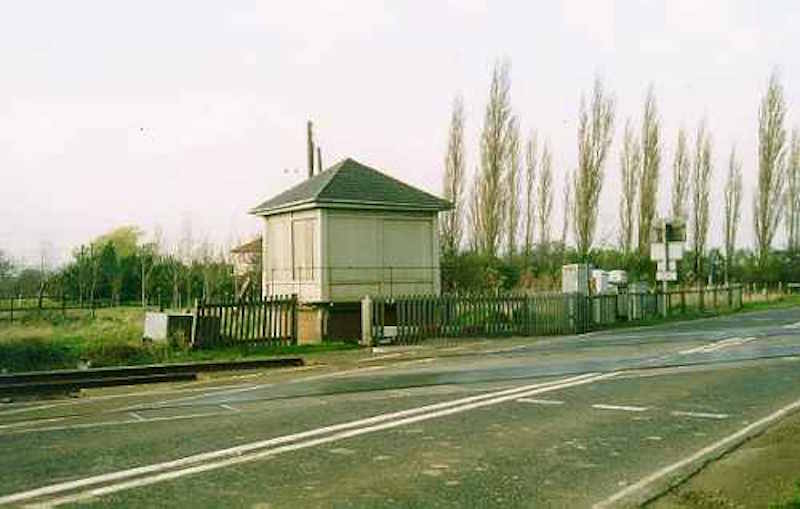
Cottage Lane Crossing, Collingham
The diminutive 10’ square box is boarded up and painted grey and is retained "for emergency use".
Collingham Station
The same situation exist at Collingham Station with a Type 3a on the Up side at 22m 13ch, across the road from the platforms. This box opened on 28th April 1901 replacing a box dating from before 1st November 1875. It succumbed to AHB on 17th December 1967.
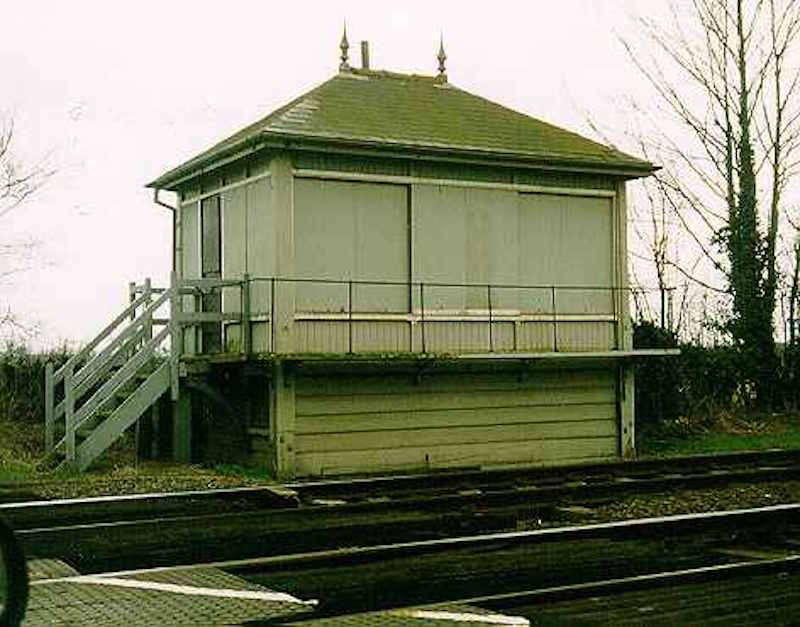
Collingham Station
Swinderby
Over two more AHB crossings — formerly residential crossing keepers, not signal boxes and into Lincolnshire. Swinderby box is at the Lincoln end of the station, again across the road from the platforms. It is a Type 3a on the Up side at 24m 67ch. It contains a Midland tumbler frame with the almost obligatory 16 levers. Being the second box here, this one hails from 6th January 1901.
Swinderby’s crossing is hand worked and, in many ways, this box resembles Thurgarton and Fiskerton further up the line. Rather that being locked by the frame, the gates are locked by an Annett's Key.
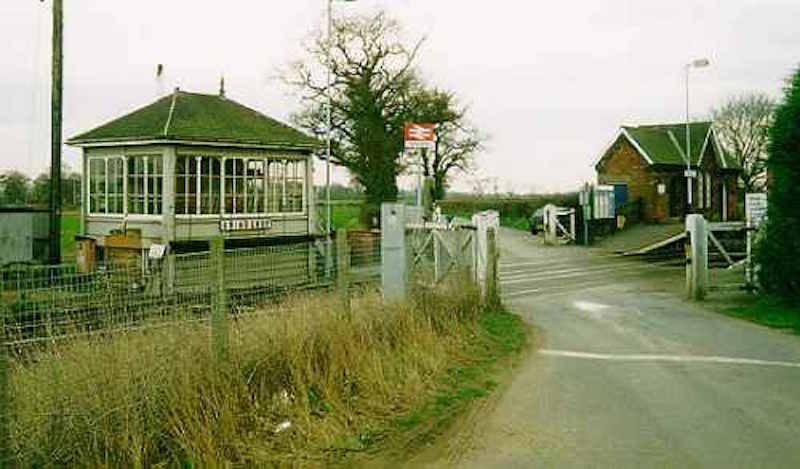
Swinderby
John Hinson's diagram dated 17DEC1967 shows an IBS section called on the Up, close to South Scarle AHB crossing at 24m 31ch. It was called, appropriately, South Scarle.
Semaphore home signals are retained but both distants are colour lights. The siding on the Down side with trailing connections to both lines shown on the 1967 diagram has gone but the crossover remains.
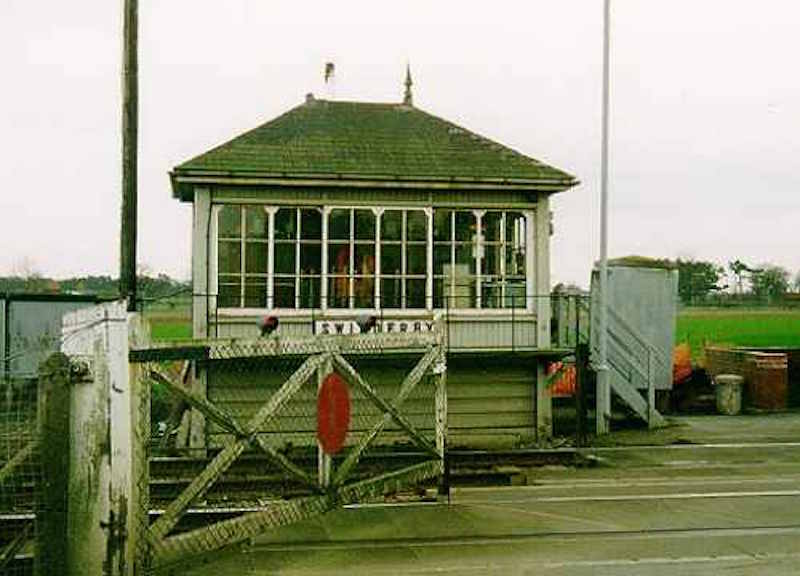
Swinderby
Thorpe on the Hill
Thorpe on the Hill station closed to passengers on 7th February 1955 but the signal box on the Up side at 27m 28ch lasted until 19th March 1988 before AHBs appeared. Although not as old as Swinderby, it was an Edwardian replacement for an 1875 structure, being opened on 12th May 1907.
Yet again there was a 16 lever frame housed in a Type 4a box measuring 15’ long by 10’ wide and like Swinderby this box had a siding on the Down side with trailing connections on both lines. It retained this siding to the end with two spare levers.
Hykeham
In contrast to Swinderby, Hykeham station is still open but its signal box at 29m 45ch was abolished on 9th November 1886 being replaced by two ground frames. The proximity of Doddington Ballast Sidings signal box probably played a part in this.
Doddington Ballast Sidings
Until 23rd March 1980 Doddington Ballast Sidings was located on the Up side at 30m 19c and dated from 15th May 1898, replacing the original 1877 box.
In 1956 all 12 levers in the frame were in use with a trailing crossover on either side of the crossing with the westernmost crossover forming a trailing slip from the Up to a siding on the Down side. As early as 1956 both Starting signals were shown as being locked on the Block. Was this Midland Rotary Block?
Boultham Crossing
At 31m 17c on the Up side we would have found Boultham Crossing signal box, at least until 19th March 1988 we would. Being a replacement for a box of 1877 which wasn’t a block post, the new structure opened on 19th April 1925.
In 1969 all 16 levers were in use with three different sidings serving the multitude of industrial premises then existing on the Down side. All three sidings has trailing connections with the middle on being via a crossover and slip to the Up line just east of the crossing.
The level crossing was to the east of the box and is an unclassified road to Skellingthorpe.
Lincoln West
Up until 13th May 1985 our journey would have continued into St Marks Station past Lincoln West on the Down side at 32m 38ch However, from that date, a new chord diverts us into Lincoln Central past GCR boxes at West Holmes, East Holmes & High Street crossing. St. Mark’s and its boxes closed.
Lincoln West was a 3rd December 1893 replacement for a 1877 structure. In 1964 all its 16 levers were in use. As well as supervising a level crossing the box had sidings on both sides of the line controlled by two ground frames.
The western ground frame was called “Ruston Proctors” and before that “Messrs Ruston & Hornsby’s Foundry Siding”. When a train was required to work into the sidings which were on the Down side but with a trailing connection from the Up line, the signalman had withdraw an Annett’s Key from the frame locking the Up Main Starting signal (3) at danger. A shunt signal was provided under it (13) to enable the train to run past the connection and set back. On returning from its shunting the train would run 'wrong line' along the Up as far as the level crossing. There a shunt signal on the Up protected the crossing from that wrong line movement.
The other ground frame worked a connection on the Up side. This led to another siding owned by Messrs Ruston Proctor Co. as well as Cannon & Co. and Foster & Co. This ground frame was released by a Staff Key which was round and coloured black. It was kept in the Yard Foreman's office.
Lincoln Station
Lincoln Station was on the Down side at 32m 56c at the entrance to St. Marks Station. It was preceded by a 1877 vintage signal box which this box replaced on 15th November 1903. It had a 20 lever frame which at its prime had no spares.
As well as working to Lincoln West, beyond the High Street level crossing at the east end of the station it worked to Lincoln East Goods.
Arguably the most unusual signalling structure anywhere is at Lincoln St Marks. Situated to the east of the level crossing over High Street there is a hexagonal brick and stone building which resembles a castle. This was the gate house for the crossing which also formed the boundary between the Midland and the Manchester, Sheffield and Lincolnshire Railway (later the Great Central). Although on paper the boundary is to the east of the crossing, that end of the station was operated by the MSLR and it is likely that they constructed this gate house.
Although the line was extended over High Street in 1847 and attendance was provided from the outset, according to Ruddock & Pearson (see acknowledgements), this structure was probably a later replacement.
Today this charming and most unusual structure is a sandwich shop located outside Lincoln's Magistrates Court which was built on the track-bed of the MSLR line.
And Finally
So we have reached our destination. That’s not quite the end of the story though. The site of St Mark’s station has — inevitably — been turned into a shopping centre. At one corner, however, there is an uncanny representation of a Midland signal box — although being about 40’ high, 30’ wide and made of red brick kind of spoils the illusion!
Thank you for bearing with me this far! If you enjoyed it, please let me know. I’d appreciate it if any errors or omissions could be pointed out to me.
Acknowledgements & Bibliography
Dave Harris, Willington, Derby, UK.
Email: dave@derby-signalling.org.uk
Page last updated: Thursday, 26 November 2015